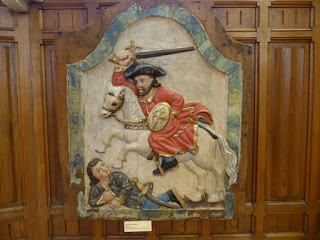We decided not to wait on the mass, the procession, etc., despite the inevitable mirth. It was hot. We proceeded on to the Gaudi Palacio, a building whose design he worked on for a time. It was to be an episcopal palace, although clearly this was at the end of the time when the princes of the church lived like princes. Gaudi purists will not find the building attractive, although there are hints and teasers throughout of what was to come. I found it more reminiscent of the crypt at
Colonia Guell. But this was still a time of architecture in crisis, not knowing which way to go: the Palacio Gaudi in Astorga was neo-Medieval at a time where everything was
neo-this or
neo-that. Later, Gaudi showed the way out. Only it was a dead-end. A beautiful and historic dead-end.
 |
Tying things together: when Hernan Cortes returned to
Spain in 1528, he brought with him something called
"cacao"; and he brought it to Astorga, from which
chocolate then spread throughout Europe and the world |
 |
We knew of this from our cacao workshop in Arequipa, Peru, back in March,
and although we did not do the Chocolate Museum in Astorga, we did buy a
bit of the good stuff... |
 |
| Entrance to the palacio |
 |
| Helpful plans |
 |
| All in tile |
 |
| "Take that, infidel tourist pig-dog" |
 |
| Cathedra, as in ex cathedra |
 |
| In the crypt; neo-Moorish? |
 |
| Gaudi restaurant, across the street |
 |
| Gaudi hardware store: he would have been so proud |


































































